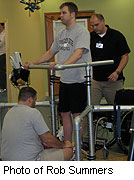
THURSDAY, May 19 (HealthDay News) — A patient completely paralyzed below the chest after an road accident has been able to stand up by himself, move his legs and feet and take some assisted steps on a treadmill, thanks to electrical stimulation of his lower spinal cord.
The technique — called epidural spinal cord stimulation — mimics signals the brain normally sends to start movement. In addition to returning voluntary movement to his hips, knees, ankles and toes, the treatment also was able to give the patient back some sexual and bladder function.
“This does not represent a cure for spinal cord injury, but it represents some very new ideas — something to build on,” lead researcher Reggie Edgerton, from the Department of Integrative Biology and Comparative Physiology at the University of California, Los Angeles, said during a press conference Thursday.
Edgerton said that the research demonstrated that patients could regain voluntary control over their movements, although so far only with the aid of stimulation.
“We have no idea what the mechanisms are,” Edgerton said. “But it is pretty certain that the stimulation and the training have resulted in changes in the brain and changes in the spinal cord. We are really anxious to find out what the mechanism is — we need to know how this occurred.”
“This is a first-generation approach, but there will be many generations to come, which will improve on what has been done,” he added.
While experts expressed excitement about the findings, they stressed that no one yet knows whether this procedure will work for patients with the most serious spinal injuries and that the results need to be replicated in other studies.
For the patient, Rob Summers, however, this is already a major breakthrough. “This procedure has completely changed my life,” he said in a statement to the press.
“For someone who for four years was unable to even move a toe, to have the freedom and ability to stand on my own is the most amazing feeling. To be able to pick up my foot and step down again was unbelievable, but beyond all of that my sense of well-being has changed. My physique and muscle tone has improved greatly, so much that most people don’t even believe I am paralyzed,” he said.
In Summers’ case, the researchers explained that when his spinal cord was stimulated in this way, nerves in the cord — plus feeling in the legs — directed the muscle and joint movement that is needed to allow him to stand and walk on a treadmill.
This was done with assistance, the researchers added. In addition, Summers has been able to stand and take steps, also with help.
In addition to epidural spinal cord stimulation to help retrain nerves there to send signals to produce certain movements, Summers underwent repeated motion training to retrain his muscles, the researchers said.
It took more than two years to complete the retraining project. After that, the device that causes electrostimulation was implanted in Summers’ back. Before that, Summers had no voluntary control over his movement, the investigators said.
The report was published in the May 20 online edition of The Lancet.
Whether epidural spinal cord stimulation will work with most spine injured patients is unknown. Summers was classified “B” on the American Spinal Injury Association system, meaning he had some sensation below the point of the injury.
However, if epidural spinal cord stimulation will have any benefit to patients classified as “A” — where there is no sensation below the injury — is unclear, the researchers said.
Other concerns focus on whether it will be possible to develop better hardware — currently, the researchers are using a stimulation device originally designed to relieve pain. In addition, experiments in animals have shown that some drugs might improve the response, but right now they are not approved for human use, the researchers noted.
Gregoire Courtine, from the Experimental Neurorehabilitation Laboratory in the Department of Neurology at the University of Zurich in Switzerland and co-author of an accompanying journal editorial, said that “this is good evidence that the human spinal cord responds to stimulation, [a technique that] was observed in rats.”
Courtine thinks it’s too early to know what this bodes for the treatment of spinal cord injury. “This is only one patient,” he said. “But this is the first time someone with a chronic complete paralysis has shown recovery of some movement.”
Whether it will work with patients with the most serious injuries is uncertain, Courtine said. “But there are patients with less serious injury in whom you may expect even better recovery,” he said.
“We are entering a new era, but it’s only the beginning,” Courtine said. While this is not a cure, it could lead the way to help patients regain movement, he said, adding that improved technology and clinical trials will be needed.
Another expert, Dr. Steven Vanni, an assistant professor of clinical neurosurgery, Spine Service, at the University of Miami Miller School of Medicine, said that “if they can replicate this, [it] would be something we could offer our patients currently, with patients with these type of spinal cord injuries.”
As for Summers, he is optimistic that the procedure will transform his life still further. “I believe that epidural stimulation will get me out of this chair,” he said.
More information
For more information on spinal cord injury, visit the U.S. National Library of Medicine.

